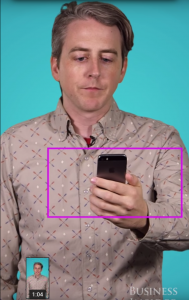Our second article in a three part series on vertical video takes a look at the impact the format will have on the way video advertisements are conceived, produced and filmed.
That hilarious PSA on the dangers of vertical video was made four years ago, if you can believe it.
Critics like the ones in the video usually make the same arguments each time they get riled up about the rise in popularity of this format:
-Watching a vertical video horizontally, as you would on a computer screen, means a loss of space and the appearance of annoying black bars.
-Our horizontal field of vision is wider than our vertical one. Therefore, the devices on which we watch videos and/or the format of those videos should be horizontal, too.
But neither of those things matters when you’re talking about mobile. First of all, if a screen is held straight up, a vertical video will fill the entire screen, leaving no empty space. Second, it may be true that humans are more comfortable moving their eyes horizontally than vertically, but we hold small mobile devices far enough away from our faces that the field of vision argument doesn’t pan out. The screen fits into our horizontal field of view just fine, as illustrated by Business Insider in the image below.

Perhaps the most important argument for vertical video is the fact that we need to follow user behavior, which, right now is trending towards heavy mobile usage (over 20% of Millennials are mobile-only). More importantly, at least 15% of online video is being watched on vertical devices and the results have been staggering; Snapchat’s found that vertical advertisements are viewed to the end nine times more frequently than horizontal ones. As Gerry Graf, the founder/chief creative officer at Barton F. Graf 9000, explains, this discovery has brought us the first big online ad format conversation about aspect ratio, which is definitely something that needs to be acknowledged. And like any new video mobile format, vertical video is gaining even more traction because it’s available programmatically.
It’s about user experience
It’s obvious that the better the user’s experience, the more likely he is to watch an ad through to the end. And vertical video is just easier for people to deal with. The natural way to hold a smartphone is in one hand in an upright position. Nick Bell, Head of Snapchat’s content, explains the appeal of vertical video well, “You don’t have to turn the phone, you don’t have to zoom in, you don’t have to expand the window…it’s just right there and the story is right in front of you.”
In short, if people aren’t rotating their phones, we shouldn’t make them. Especially if they don’t want to. But does that mean that we’ll have to change the way we think about producing advertisements for mobile?
Yeah, kinda.
Will Vertical Videos Change Video Production Methods?
We’re in a transition period now, so advertisers are still getting comfortable with the idea vertical video. There are bound to be hiccups, but producers are adapting quickly to the format.
For example, Tastemade, a Food Network-backed TV show that produces videos for Snapchat’s Discover channel, has invested in “vertical friendly” sets and production methods; cabinets and food cans are lean and the cameras used to film the show are propped on tripods vertically. Their production set is built around the concept of vertical video. For them, the power of this new format was worth the potential hassle of re-thinking set design.

Tastemade Studio
And if producers don’t want to completely rebuild sets or swivel their cameras around, they can focus more on best practices, such as concentrating on what kind of scenes and subjects to film vertically. Just like in photography, there are certain elements, like close-ups of people and tall, skinny objects (think skyscrapers, basketball players, tress), that work well in portrait.
Graf was dead on when he said, “The key to nailing content for the platform starts with the concept,” Basically, for certain situations, certain types of videos and certain subjects, vertical is just works better. And publishers are following heed. Jon Steinberg, the chief executive of The Daily Mail’s North American operations says they’re working on getting 100% of their videos vertical, “We find the engagement much higher. Users are more satisfied, and there’s a higher completion rate on them.”
This isn’t new!
Even if vertical video is the future, producers can look to the past for ideas about how to go fully vertical. The vertical cinema movement has been around for a few years now— there is even an annual European festival, dedicated to viewing films made especially for tall, narrow screens. Vertical Cinema screenings are often in locations with high ceilings, like churches. The creators explain that the event’s goal is to promote a different manner of thinking about visuals, space, and the filmmaking of tomorrow, “This project rethinks the actual projection space and returns it to the filmmakers. It proposes a future for filmmaking rather than a pessimistic debate over the alleged death of film.”

First Showing of Vertical Cinema at Grey Friars Church in Austria
The Vertical Cinema movement is still on the outskirts, but it might just help those creating film for mobile get a better idea of how and what to film in portrait. In any case, the manner in which mobile advertisements are conceived is bound to change now, not only because the format exists, but because viewers seem to be fixated on it.
All that said, when catering to mobile devices, fully vertical video isn’t your only option!
What if my advertisers don’t have a fully vertical video to offer?
Ever try to convert a 16:9 image into 4:3? You can’t just throw it into photoshop, change the length and width and expect it to fit perfectly into the desired ratio. Either your image is too big, too small or completely deformed. It’s the same when with video. To make a horizontal video fully vertical, you need graphic designers and talented producers to do some serious work.
But what if the advertiser can’t provide a fully vertical creative? Is there an easy way to fill up a screen held vertically without having to transform the aspect ratio of a video?
YES!
And it requires no extra work by on either the buy or sell end. In the next blog post of this series, we’ll explain how easy it is to go vertical even if all you have is a horizontal video.
Sources
Business Insider: https://www.youtube.com/watch?v=zz3Snlq1ADw
Vertical Video PSA: https://www.youtube.com/watch?v=Bt9zSfinwFA, http://saynotoverticalvideos.com/
Vertical Cinema: http://verticalcinema.org/, http://verticalcinema.org/about
http://www.slashfilm.com/meet-the-vertical-cinema-movement/
http://www.theverge.com/2014/2/18/5420662/if-portrait-video-is-wrong-these-artists-dont-want-to-be-right
http://www.adweek.com/news/technology/now-vertical-video-finally-legitimate-creatives-need-rethink-everything-166345
http://www.nytimes.com/2015/08/13/technology/personaltech/vertical-video-on-the-small-screen-not-a-crime.html?_r=0
http://gizmodo.com/5915888/an-important-psa-on-why-you-should-never-shoot-videos-vertically
http://digiday.com/platforms/time-take-vertical-video-seriously/
https://wistia.com/community/posts/qdf6/what-should-we-video-marketers-do-about-vertical-video
https://medium.com/@jonsteinberg/vertical-video-86a68c45ac06#.z8u8gob7b
http://digiday.com/platforms/hearst-comes-way-replay-vertical-video-ads-snapchat/
https://www.comscore.com/Insights/Blog/Mobile-Internet-Usage-Skyrockets-in-Past-4-Years-to-Overtake-Desktop-as-Most-Used-Digital-Platform
http://www.usatoday.com/story/tech/2015/09/23/vertical-video-pays-off-snapchat/72661508/
